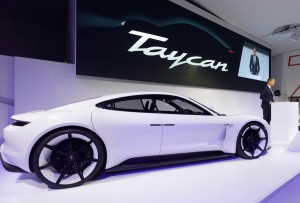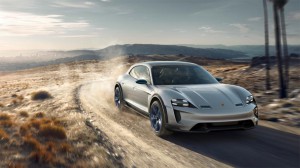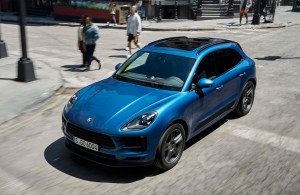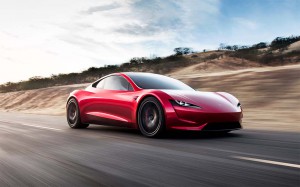
The new Porsche Taycan, formerly known as the Mission E, is just the beginning of a slew of new battery-electric cars coming from Porsche.
Porsche is not only just getting ready to roll out its first pure battery-electric vehicle, the Taycan, but also it apparently sees the opportunity to electrify more of its line-up, with battery-powered products generating more than half its sales by 2025.
The automaker revealed one possibility at the Geneva Motor Show last winter, a concept battery-SUV dubbed the Mission E Cross Turismo that is essentially a high-riding version of the original Mission E concept that will become the Taycan sports car when it goes into production next year. Alternatively, the performance division of Volkswagen Group could electrify the smaller of its two current crossovers, the Macan. And still models will follow, according to Porsche’s chief financial officer.
“There is no final decision yet, but you can expect that this will be the case because we need a large-volume model that is fully electric. This idea will then progress further with the next generations of the Panamera and Cayenne model lines,” CFO Lutz Meschke told reporters during a tour of the company’s product development center.
Porsche’s parent Volkswagen Group, as a whole, is making a heavy push into battery power, with an estimated 50 BEVs planned for its various brands by the middle of the coming decade – though VW CEO Herbert Diess today stressed that the company does not intend to willingly walk away from its gas and diesel lines.
(Porsche dropping diesels. Click Here for the story.)

The Porsche Mission E Cross Turismo is just a "study" for now, but expect a production version to follow.
Porsche, in particular, has outlined plans to invest 6 billion euros, or nearly $7 billion at the current exchange rate, in electrifying its line-up during the next four years alone. In contrast with the VW brand, it has now laid out plans to abandon diesels during the next several years.
“We’re a relatively small company, and we will not be able to afford to offer a combustion-engine version in addition to pure-electric models in the long term,” he explained, noting that while there will be an “overlap of two to three years,” diesels will be gone from the line-up early in the coming decade.
It appears that Porsche will focus on bigger models, such as the Panamera, Cayenne and Macan, first in its push to electrify existing models. That surprises no one as larger platforms also provide more room for battery packs. But the CFO also indicated that Porsche sees the opportunity to eventually electrify even its two small sports cars, the Cayman and Boxster, as “feasible.”
“Pilot projects that we have run since 2010 have clearly shown that pure electrification would be feasible in such a segment,” said Meschke.
As for the 911? Porsche CEO Oliver Blume recently suggested a plug-in hybrid version is coming, but not until 2023. For those who want something sooner, they’ll have to settle for the Taycan, which is roughly the same size.
(Click Here to see more about Porsche expanding its subscription service.)

The Porsche Macan is one of four of the brand's vehicles that will see some form of electrification by 2023.
Its name derived from the Turkish word for a “lively young horse,” Taycan relies on two electric motors, one on each axle, generating a combined 600 horsepower. That will help it launch from 0 to 60 in an estimated 3.5 seconds. Top speed is rated at 155 mph.
Off-the-line, Taycan actually won’t quite keep up with a Tesla Model S sedan with optional Ludicrous Mode. It can hit 60 in the low two-second range. But Ludicrous Mode can only be used with a relatively full battery and, even then, only a handful of times per charge. The Tesla also has a tendency to have its batteries and motors heat up when driven to the limits, so it cannot be driven flat-out for an extended period of time. Porsche, however, claims the Taycon will be able to be driven much like any of its other models, such as the classic 911, a driver pushing the limits at will.
Whether Porsche can achieve its goal of generating at least half its sales with BEVs by the middle of the coming decade is far from certain. Worldwide, fully electric vehicles still account for less than 1% of total new car demand, but that has begun to grow rapidly, especially in key markets like China, as more long-range offerings come to showrooms, and as new emissions regulations go into effect.
If anything, luxury and performance brands appear particularly focused on electrification. That reflects several factors:
- High-line buyers appear more willing to swallow the added cost of battery technology;
- And while early BEVs were sluggish, manufacturing focusing on range, electric motors can deliver incredible performance, as the Tesla Model S with Ludicrous Mode first demonstrated.
Tesla itself is getting ready to launch an all-new version of its original Roadster, CEO Elon Musk claiming it will hit 60 in barely two seconds. Other performance brands, including Aston Martin, Ferrari, Lamborghini and Maserati also plan all-electric offerings. And Aston Martin is working up a new version of its top-line 8C that will use a plug-in drivetrain to punch out more than 700 horsepower.
(To see more about Porsche renaming the Mission E to Taycan, Click Here.)
The big challenge, going forward, for brands like Porsche will be finding ways to differentiate their electric offerings from key competitors, industry analysts stress.


“…finding ways to differentiate their electric offerings from key competitors…”. The only thing that has changed is the drivetrain. All ICE vehicles have essentially the same drivetrain, yet these cars are sufficiently differentiated in the minds of the consumers. Are BEVs some kind of perception issue for consumers?
Drivetrain technologies, especially amongst performance cars, have very distinct personalities: torque curves, torque vectoring, exhaust notes, etc. That differentiation would be far less distinct with BEVs.